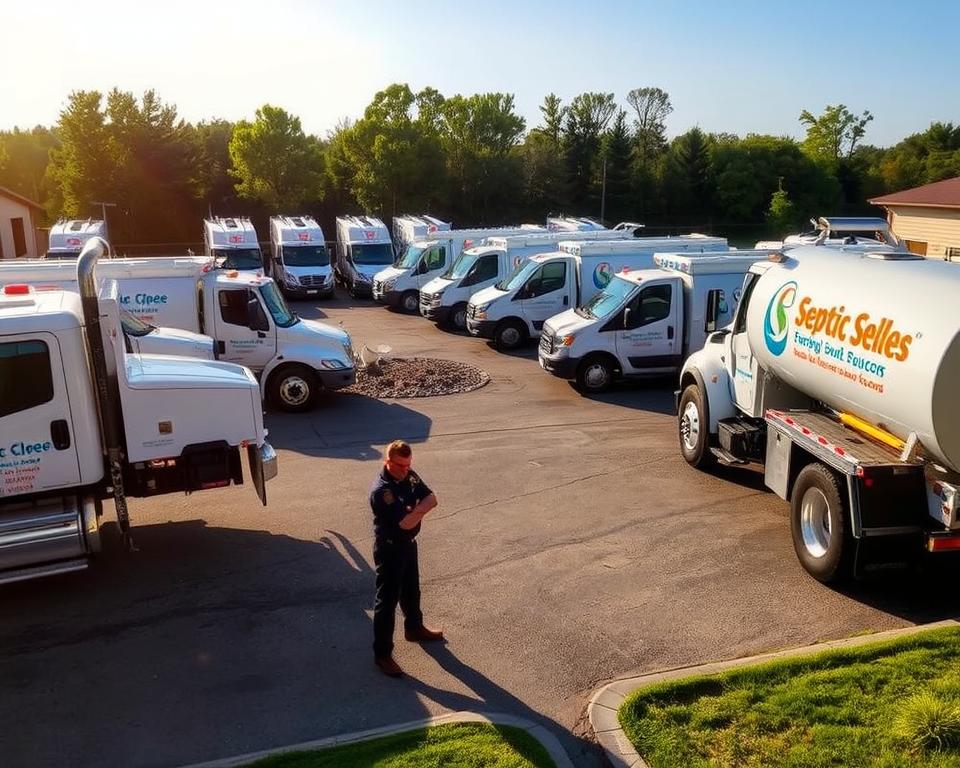Grease Trap Pumping: Maintain Your Kitchen Running Smooth
Ever pondered the function of a small gadget in preventing commercial kitchen plumbing catastrophes? Grease interceptor pumping transcends mere maintenance—it’s crucial for effective restaurant culinary refuse management. These traps, crucial for collecting fats, oils, and grease (FOG) produced during food prep, avert clogs. Without regular cleaning, they can clog, causing costly repairs and operation interruptions. Let’s explore the significance of grease trap cleaning and its part in maintaining a smooth kitchen functioning, all while complying to environmental standards.
Understanding Oil Interceptors and Their Significance
Oil traps are vital for the smooth running of business kitchens and meal handling establishments. They capture grease, fats, and solid refuse before they reach the drainage system. This function is key for maintaining culinary hygiene. It’s essential to grasp how these interceptors work to make certain they work efficiently and maintain a clean work environment.
What are Oil Interceptors?
A grease interceptor, also known as a septic grease trap cleaning, is a gadget intended to collect fats, oils, and grease (FOG) from effluent. Placed in the pipework of culinary spaces or food serving establishments, it prevents these materials from going into the sewer system. This prevents backups or clogs in conduits, avoiding expensive fixes and potential hygiene issues.
How Do Grease Traps Function?
The functioning of grease traps is depends on weight separation. Wastewater enters the trap, where denser solids settle at the bottom. Meanwhile, lighter grease and grease rise to the surface, forming a film of FOG. This setup allows cleaner water to exit the interceptor and flow into the sewer system.
Frequent inspection of grease traps is key for their best performance. Upkeep includes taking out collected FOG and particles to stop spillage and system breakdown. Correct fats, oils, and grease removal through timely maintenance ensures kitchens operate seamlessly and ensures hygiene.
Typical Problems with Oil Interceptors
Grease traps are vital for keeping kitchens sanitary and efficient, particularly in the meal serving sector. Ignoring them can lead to various issues that affect functions. Understanding these problems helps in focusing on sewage system maintenance for better functionality.
Clogs and Obstructions
Blockages and blockages are major concerns with grease interceptors. They often stem from fats, oils, and greases (FOG) accumulation. This buildup can block liquid movement, causing drainage clogs. Thus, regular drain line cleaning is essential to stop these clogs. Regular checks assist identify blockages in advance, stopping bigger issues.
Bad Smells and Pest Infestations
Ignoring grease interceptors also causes foul smells and pest invasions. Collected organic matter leads to unpleasant smells, making the kitchen undesirable to occupy. These odors attract pests, increasing hygiene risks. A consistent cleaning routine for grease traps is key to managing food service industry refuse effectively. It guarantees a clean, pest-free space, promoting a healthier kitchen atmosphere.
Grease Trap Pumping: Crucial Maintenance for Your Kitchen
In the world of restaurants and business culinary spaces, grease interceptor cleaning is paramount for upkeep. Making sure your grease trap stays in optimal shape is crucial for both operational effectiveness and environmental compliance. It’s vital to understand the best pumping frequency and to recognize indicators that signal the necessity of service. This knowledge can greatly lower costs and save time over time.
Frequency and Scheduling of Pumping
Choosing the correct cleaning frequency for grease traps hinges on various factors. The capacity of the trap and the volume of fats, oils, and grease (FOG) your kitchen generates are important considerations. Generally, it’s recommended to clean grease traps every 1 to 3 months. Frequent inspections help ensuring smooth functioning and compliance to regional legal standards.
Signs That Your Oil Interceptor Requires Cleaning
Staying alert for indicators that your grease trap requires pumping can prevent major problems. Watch for these indicators:
- Slow drains: If basins drain more slowly than normal, it could mean the grease trap is full.
- Regular pipework backups: Regular backups suggest a grease interceptor struggling to manage waste volume.
- Foul smells: A bad odor near the interceptor signals it’s necessary for cleaning.
Handling these indicators quickly improves performance and ensures ecological compliance for restaurants. Regular maintenance prevents costly fixes and fosters a hygienic culinary space.
Advantages of Frequent Oil Interceptor Maintenance
Frequent maintenance of grease traps is vital for your culinary space’s effectiveness and operation. A consistent routine for inspections and clearing prevents disruptions and ensures a safe, sanitary culinary space. This preventative method is key to a efficient kitchen.
Preventing Costly Repairs
Preventative maintenance helps kitchen operators spot and fix problems early. Routine checks uncover clogs and obstructions, avoiding expensive fixes that could halt functioning. Each maintenance visit makes sure grease interceptors work well, reducing the risk of plumbing failures and urgent issues.
Improving Kitchen Hygiene
Frequent maintenance of grease traps enhances kitchen sanitation. It reduces grease and food fragments, lowering the danger of bad odors and microbes. A sanitary grease interceptor provides a more secure culinary space and meets meal hygiene standards, essential for patron contentment. Effective upkeep has a significant positive effect on kitchen functions.
| Advantage | Explanation | Effect on Kitchen Functions |
|---|---|---|
| Financial Benefits | Reduces the chance of unplanned pipework problems that incur expensive repair costs. | Ensures consistency of business without unexpected interruptions. |
| Enhanced Hygiene | Minimizes foul smells and bacteria associated with grease buildup. | Provides a sanitary and secure space for food cooking. |
| Adherence | Fulfills legal standards by ensuring sanitation. | Prevents fines and regulatory problems related to poor kitchen hygiene practices. |
Choosing the Right Oil Interceptor Maintenance Provider
Choosing a reliable grease interceptor cleaning provider is crucial for maintaining top functioning in restaurants and commercial kitchens. It’s important to choose a company with broad experience in grease trap maintenance. Firms like Oil Trap Pumping Company guarantee compliance with local standards and provide thorough maintenance to keep your grease interceptors functioning.
Expertise and Expertise in Offerings
A reputable provider has a demonstrated track record in managing grease interceptors effectively. Their knowledge in business plumbing services allows them to identify possible issues in advance. With experienced technicians, businesses can anticipate thorough cleaning and upkeep routines customized to each culinary space’s individual requirements. This method extends the life of the drainage system.
Environmental Accountability in Waste Management
Provider quality isn’t the sole factor; ecological compliance is equally important. The best grease trap cleaning company emphasizes sustainable waste disposal practices. Efficiently managing the gathering and disposal of grease and particles demonstrates a dedication to sustainability. By selecting a provider that aligns with these values, companies can ensure their grease interceptor upkeep is both effective and eco-friendly.



